
Deliver high-impact leadership training
Equip employees at every level with the skills necessary to lead.
Every organization seeks to establish a program that develops the next generation of leaders.
But the most successful programs develop leaders at all levels of the organization, not just those who are next in line on the succession plan.
“You’re investing in everybody,” Cynthia Rowan, president of Performance Management Solutions, tells 2019 CUNA Human Resources & Organizational Development Council Conference attendees Tuesday in Anaheim.
Rowan suggests several steps to create a high-impact leadership development program that equips employees at every level with the skills necessary to lead:
• Assess, define, and develop. Think about leadership development and why you want to implement a program at your credit union. Define the purpose and desired outcomes, and tie them to your organization’s mission and values.
Also, identify the competencies—what leadership looks like—at all levels of the organization and how you’ll identify leadership effectiveness.
“That’s critical,” Rowan says. “You’re investing in everybody.”
• Gain commitment. Senior leadership must embrace the philosophy behind the program and clearly define their role.
• Create a process. Three pieces are necessary for successful program:
- Training to address emotional intelligence, communication skills, change management, and team talent development. “Leadership development is a journey,” Rowan says. “You have to look at yourself and how you react.”
- Experiences. Assign employees to special projects or involve them in cross-departmental projects to allow them to grow their leadership skills. “The people who are most valuable to an organization have not only depth, but a breadth of knowledge,” Rowan says. “They have a clearer understanding of how all of the pieces fit together.”
- Infrastructure. Include coaching and mentoring to allow employees to grow. “Infrastructure is the glue that holds it all together,” Rowan says. “If not, you have an event-based program and it will be an expense.”
• Implement the program. Spend one-quarter of your time building the program, another quarter delivering the program, and the rest of your time sustaining it with coaching and mentoring.
“This is where the program becomes an investment and not an expense,” Rowan says.
• Evaluate. Find out what participants learned, how they incorporate new skills into their daily work, and how this impacts the credit union’s retention, profitability, and competitiveness.
Visit CUNA News for more conference coverage, and get live updates on Twitter via @CUNAJennifer, @CUNA_News, @cumagazine, @CUNACouncils, and by using the #HRODCouncil hashtag. Learn more about the CUNA HR & Organizational Development Council, a member-led professional society for credit union executives, at cunacouncils.org.